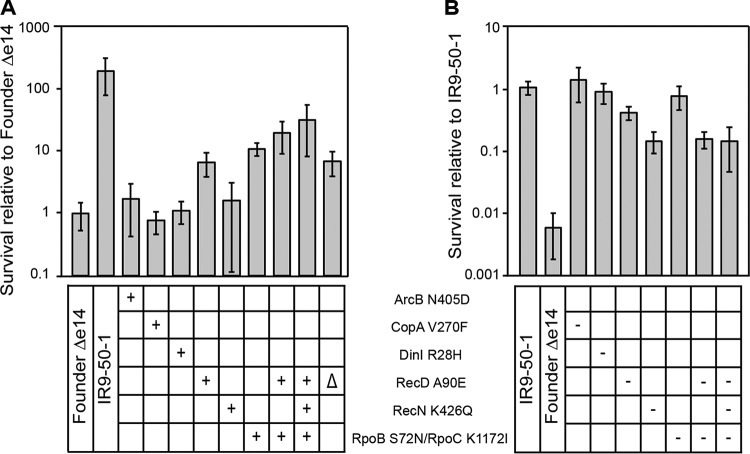FIG 9.
Mutations which contribute to IR resistance in the evolved isolate IR9-50-1. (A) IR resistance of Founder Δe14 derivatives containing mutations from lineage IR9. Mutations were moved singly or in combination from IR9-50-1 (in the case of ArcB N405D, from IR9-20-1; the recD deletion was made in the Founder Δe14 parent strain) into the Founder Δe14 strain background as described in Materials and Methods. A “+” symbol indicates that the variant is present in that strain. (B) IR resistance of IR9-50-1 derivatives containing reversions of mutations to the wild-type sequence. Wild-type sequences of the gene encoding the indicated protein variants was moved from Founder Δe14 into IR9-50-1 as described in Materials and Methods (IR9-50-1 does not have a ArcB variant, and therefore no reversion was tested in this strain). A “–” symbol indicates that the variant was reverted to the wild-type allele in that strain. Each strain was assayed for IR resistance alongside biological triplicate of the parent strain (a Founder Δe14 or IR9-50-1 control), and the average percent survival of the experimental strains was compared to that of the parent strain. All strains were exposed to 1,000 Gy of electron beam IR, and the percent survival was determined via calculating CFU/milliliter before and after irradiation. Error bars represent the standard deviations of CFU/milliliter calculations from at least two independent experiments performed in biological triplicate. Statistical significance of percent survival relative to the parent strain was determined using a two-tailed Student t test. * and ***, P < 0.05 and P < 0.001, respectively.

